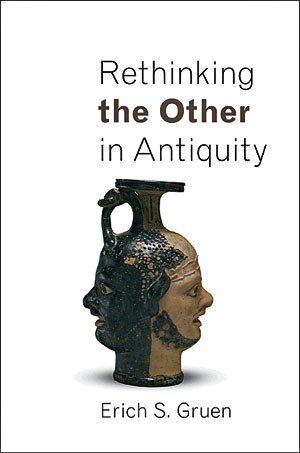
How do nations, peoples, and ethnic groups fashion their own collective identities? For antiquity as well as for the modern era, one general answer has prevailed: societies shape their self-consciousness by framing a contrast with the “Other.”
The creation of distorted mirrors highlights the distinguishing features of one culture by playing them off against the stereotypes or negative images ascribed to ostensibly dissimilar societies. The differentiation has promoted conventional antinomies like Greek/barbarian, Jew/gentile, civilized/savage, advanced/backward, and righteous/degenerate. The common scholarly view holds that disparagement of alien cultures serves to develop the inner portrait, an essential ingredient in establishing self-esteem and claiming superiority.
Rethinking the Other challenges standard orthodoxy. It shows another side to this story and turns it on its head.
I attempt to show that when ancient peoples rediscovered their roots and recounted their history, they often did so by finding or claiming links with other societies, by pointing to cross-currents and overlaps that placed less emphasis on differences than on shared heritage within a broader Mediterranean setting.
The book moves beyond hostile stereotypes, distortions, and caricatures. It argues that linkages among peoples, whether real or fictive, played a larger role in mutual perceptions than antithesis, disparity, or rejection.
The interconnections appear in foundation myths that drew on diverse cultural traditions, stories of migratory movements, fictive genealogies, and invented kinship relations—a form of “togetherness’ rather than “otherness.” Readers of the book will find a web of complex associations among cultures and societies that undermine simplistic dichotomies and disclose a drive by the ancients to stress bonds rather than barriers.
The book is divided into two large sections: “Impressions of the Other” and “Connections with the Other.”
The first part, composed of eight chapters, examines Greek and Roman representations of Persians, Egyptians, Carthaginians, Gauls, Germans, and black Africans. It argues that the descriptions and characterizations, far from exhibiting simplistic stereotypes, display subtle characterizations that resist reductive placement into negative—or, for that matter, positive—categories.
The four chapters that make up the second part explore fictive genealogies, foundation legends, and stories of multiple migrations that underscore connections between cultures rather than disassociation and estrangement. They disclose the manner in which Mediterranean peoples encountered, even embraced, the traditions of others and introduced them into their own self-consciousness.
All societies engage in myth-making about their pasts. The tales speak to the image that they wish to project not only to an external world but to themselves. How far do they represent reality? That question engages much historical research and writing. But the extraction of fact from fiction does not exhaust the mission of the historian. The creation of fictive tales is itself a historical fact—and one that can bring real insight into the understanding of a culture’s values and aspirations.
We learn, for instance, that the ancient Egyptians, after encountering the worlds of the Greeks and the Jews, produced or embellished a notable set of stories. An Egyptian narrative, conveyed by a Greek author, claimed that Cadmus and Danaus, founders of the most venerable Greek cities, Thebes and Argos, and Moses, founder of the Hebrew nation, were all Egyptian in origin.
Never mind whether the stories have any historical basis. They demonstrate not only familiarity in Egypt with Greek legends and Jewish traditions but a usurpation of them to assert Egyptian origins as the basis for glories attributed to other cultures.
This is transparently a form of cultural appropriation, even cultural imperialism. But it is more than that. By claiming credit for the achievements of others, Egypt was also associating them with their own history and rewriting their own traditions to conform to theirs. This gives a very different picture from the normal image of Egypt standing in splendid isolation from the rest of the Mediterranean. And it encapsulates the major theme of the book: the ancient penchant to discover, or fabricate, common links that crossed ethnic or national lines.
My route to this subject took some apparent twists and turns, but, in retrospect, seems perfectly logical.
A large book on the political and diplomatic history of Rome’s relations with the Greek east included, almost as an afterthought, some glances at the cultural intertwinings that those entanglements produced. That led to two further books that explored the impact of Hellenic culture upon Roman sensibilities and the manipulation of Hellenism to further Rome’s self-image.
A similar objective brought me, in two additional books, to examine the ways in which Jews of the Hellenistic period engaged with Greek culture in expanding their own horizons and developing a niche in the wider Roman world, without abandoning their own traditions. Rethinking the Other pursues this subject on a broader stage, examining the mutual perceptions, representations, and self-understandings of Egyptians, Persians, Phoenicians, Carthaginians, Jews, Greeks, Romans, Gauls, Germans, and black Africans.
If a reader were to browse at random in the book, where would s/he find a representative section that brought its central thesis most clearly to the fore? No single portion does that job as a whole.
One segment, however, entitled “Perseus as Multiculturalist,” offers a neat and intriguing illustration of the theme.
The Greek legend of the hero Perseus took a variety of forms as it meandered around the Mediterranean, massaged in different ways by diverse peoples who fastened upon it to add luster to their own self image. The great hero, who slew the hideous and deadly Gorgon and then rescued the beautiful damsel Andromeda, chained unjustly to a rock, from the assaults of a sea monster, held great appeal and fascination.
Perseus was Hellenic in conception and character. But the Greeks had no exclusive rights to him. Persians seized upon the coincidence of names and reshaped the fable to have Perseus’ son, conveniently called Perses, stay with the hero’s father-in-law who happened to dwell in the land which subsequently took his name as Persia.
The Persians even employed the fictive kinship to argue for an ancestral bond between their nation and the ancient Greek city of Argos, Perseus’ home town. The fiercest foes of antiquity, Greece and Persia, thus had a common forefather whose legend transcended conflict and warfare and challenged the concept of “Otherness.”
That was not the end of the story. Egypt got into the game as well, stressing the Egyptian roots of Perseus that went back to the myth of the god Zeus’ union with princess Io in Egypt, leading to the line of Danaids who migrated to Argos and eventually issued in the birth of Perseus himself. Egyptians then assimilated Perseus to an Egyptian deity thus appropriating Greek lore to create a combined construct.
Most remarkably perhaps, the Jews too entered into this legendary thicket. The Phoenicians had seen the attractiveness of the story and transferred the location of Andromeda’s binding and rescue to a Levantine setting, namely the harbor city of Jaffa.
When that port came under Jewish control, the Jews neatly capitalized on the classical myth. By making Jaffa the seat of Andromeda’s kingdom and the site of her rescue, they could even promote the town as a tourist attraction. They showed visitors ancient shrines dedicated to the maiden’s father, a pool of red water where Perseus wiped the blood of the leviathan off his hands, and the very marks of the chains that had bound Andromeda to the rock. A rock jutting off the coast at Jaffa still retains to this day the designation “Rock of Andromeda.” The Jews of antiquity had shrewdly adopted a Hellenic legend and transferred it to Jewish soil. They managed both to espouse a relationship with Greek tradition and to adapt it to a Jewish setting.
A prevailing view holds that animosities among peoples (whether external or internal) are fueled or exacerbated by negative typecasting that demonizes the “Other” and exalts oneself.
The classic statement of that position can be found in the powerful and influential work of Edward Said, Orientalism. Its impact remains potent, as evidenced by its mirror image, Occidentalism by Ian Buruma and Avishai Margalit, and by the widely read best-seller, Clash of Civilizations, by Samuel Huntington.
The proposition has unquestioned force. One needs only to recall George W. Bush’s explanation for the attack on Twin Towers: the attackers “hate freedom.”
That approach has wielded substantial leverage on scholarly interpretations of hostilities in antiquity. A battery of books stresses the misrepresentations and stereotypes that spurred the ancients to “invent the barbarian,” and to justify marginalization, subordination, or exclusion. For some scholars, adverse attitudes toward foreigners in the ancient Mediterranean amounted to either ethnic prejudice or proto-racism.
I offer an alternative approach.
Rethinking the Other argues that ancient societies, while certainly acknowledging differences among peoples (indeed occasionally emphasizing them), could also visualize themselves as part of a broader cultural heritage and couch their own historical memories in terms of a borrowed or appropriated past.
The establishing of a collective identity is an evolving process, no straight line but a meandering movement. To stress stigmatization of the “Other” as a fundamental strategy of self-assertion is reductive and one-sided.
Rethinking the Other turns the lens on inclusion rather than exclusion. The book shows that many ancients took the affirmative route, set the alien in a softer light, found connections among peoples, appropriated the traditions of others, inserted themselves into the genealogies and legends of foreigners, and enhanced their own self-image by proclaiming their participation in a broader cultural scene. That attitude complicated the sense of collective identity—but also substantially enriched it.


Erich S. Gruen is the Gladys Rehard Wood Professor Emeritus of History and Classics, and chair of the Jewish Studies program at the University of California, Berkeley. His books include The Last Generation of the Roman Republic (1974), The Hellenistic World and the Coming of Rome (1984), Heritage and Hellenism: The Reinvention of Jewish Tradition (1998), Diaspora: Jews Amidst Greeks and Romans (2002), Cultural Borrowings and Ethnic Appropriations in Antiquity (2005), and Cultural Identity in the Ancient Mediterranean (2011). He is a past President of the American Philological Association, a Fellow of the American Academy of Arts and Sciences, a member of the American Philosophical Society, and a recipient of the Austrian Cross of Honor for Arts and Letters.